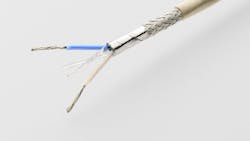Ethernet Cables Speed Data in Harsh Environments
Electronic designs for the defense sector have their own mobility and portability goals driven by size, weight, and power (SWaP) requirements. Ethernet cables have been one component that has been difficult to shrink without performance sacrifices, until now. TE Connectivity's new Raychem single-pair Ethernet (SPE) cables handle the harshest environments in aerospace, commercial, industrial, military, and space environments, providing critical interconnections in such applications as unmanned aerial vehicles (UAVs) and electric vertical takeoff and landing (eVTOL) aircraft.
“The single-pair Ethernet cable allows commercial and defense customers to maintain data rates, while reducing size and weight by up to 75% when compared to existing Quadrax systems,” said Lynden Bajus, product manager for TE’s Aerospace, Defense and Marine division. “TE’s ability to ruggedize an automotive standard to help meet the harsh environment requirements in aerospace, defense, and marine markets, has allowed us to focus on improving size and weight parameters for our customers while continuing to maintain critical data-rate needs.”
The compact, lightweight construction of the Raychem SPE cables supports 100-Mb/s or 1-Gb/s data rates through single-pair cable assemblies (see the figure). The cables are standardized under the ARINC 854 cabin equipment network bus standard and are available in both AWG 24 and 26 cable sizes. They are designed for operating temperatures from -65 to +150°C. By complementing the firm’s 369 shielded connectors, the Raychem SPE cables reduce termination time and simplify maintenance compared to standard eight-wire cables and rectangular connectors.
About the Author
Jack Browne
Technical Contributor
Jack Browne, Technical Contributor, has worked in technical publishing for over 30 years. He managed the content and production of three technical journals while at the American Institute of Physics, including Medical Physics and the Journal of Vacuum Science & Technology. He has been a Publisher and Editor for Penton Media, started the firm’s Wireless Symposium & Exhibition trade show in 1993, and currently serves as Technical Contributor for that company's Microwaves & RF magazine. Browne, who holds a BS in Mathematics from City College of New York and BA degrees in English and Philosophy from Fordham University, is a member of the IEEE.
